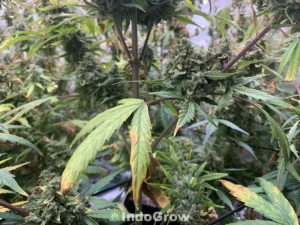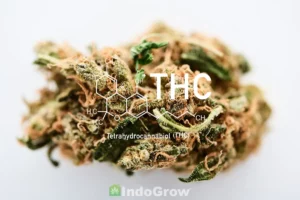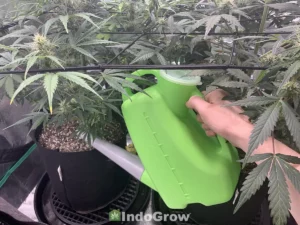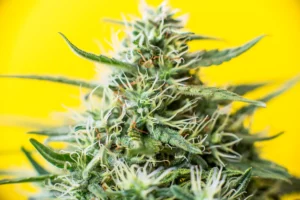Using the best nutrients for growing weed is essential for maximum yields and quality. The types of nutrients needed varies based on growing mediums, stages of growth, and the types of cannabis being grown.
Nitrogen, phosphorus, and potassium are the most important nutrients for cannabis and are needed in different amounts at different stages of growth. However, they are not the only nutrients that growers should utilize. Continue reading to learn about the best nutrients for growing weed.
Table of Contents
- Cannabis Nutrients for Soil Grows vs Hydroponic Grows
- Liquid vs Powder Cannabis Nutrients
- Organic vs Synthetic Cannabis Nutrients
- Best Cannabis Nutrient Brands and Products
- Best Nutrients for Seedlings
- Best Cannabis Nutrients for the Vegetative Stage
- Supplemental Nutrients for the Vegetative Stage
- Best Cannabis Nutrients for the Flowering Stage
- Supplemental Nutrients for the Flowering Stage
- Summary
Cannabis Nutrients for Soil Grows vs Hydroponic Grows
Cannabis plants obtain nutrients differently depending on the growing medium. In soil grows, the roots feed off minerals in the soil from both the nutrients supplied by the grower as well as from the natural organic matter already in the soil. In comparison, plants in hydroponics setups must use their roots to constantly feed off nutrient solutions from the water.
The main nutrients for grows of any type are nitrogen (N), phosphorus (P), and potassium (K). This is what the NPK on most nutrient labels stands for. For hydroponic grows, these nutrients must be added to the water consistently throughout the entire grow. Soil grows utilize the nutrients already in the soil for a few weeks before requiring supplementation.
Liquid vs Powder Cannabis Nutrients
Cannabis nutrients can be purchased in liquid and powdered forms. Both liquid and powdered nutrients are designed to be more bioavailable to plants. This means that they have been engineered to be more easily absorbed than their natural counterparts. These nutrients differ substantially in how they are dispersed and absorbed.
Liquid nutrients are usually synthetic and are dissolved in water before adding to the soil. Liquid nutrients are immediately accessible by the roots so they’re a great choice for quickly addressing nutrient deficiencies. It is recommended to be conservative when adding liquid nutrients due to the potential for nutrient burn. Always start at half the recommended strength on the bottle.
Powdered nutrients can be organic or synthetic and are designed to be slowly released into the soil with each watering. When making your own soil, powdered nutrients are mixed into the growing medium before planting. The slow-release nature of powdered nutrients means you can add less throughout the grow. When adding powdered nutrients during the vegetative and flowering stages, a 2-3 inch top dressing of the powder is added to each pot.
Organic vs Synthetic Cannabis Nutrients
The decision between using organic or synthetic cannabis nutrients is a significant one that will affect your weed plants in the long run.
The main benefits of using organic nutrients include the natural microorganisms that inhabit them and the sustainability that natural nutrients bring to a soil grow. Also, their slow-release nature substantially reduces the chance of nutrient burn. However, the slow release is a double-edged sword because the longer that plants take to absorb nutrients, the harder it is for the grower to spot and correct deficiencies in a timely manner. Organic nutrients are also less tailored to different growing mediums, less consistent between sources, and often more expensive.
Synthetic nutrients remedy many of the disadvantages of using organic by giving growers more control over their crop’s nutrient profile with an exact measured mineral ratio. This makes correcting deficiencies easier as well as cheaper. However, due to their speedy absorption, synthetic nutrients can more easily burn your plants, cause nutrient buildups, and impact the bioavailability of soil.
Choosing the right nutrient type requires assessing the needs of each growing situation and comparing them to the way organic and synthetic nutrients differ.
Best Cannabis Nutrient Brands and Products
The brand of cannabis nutrient products that growers use can make all the difference in maintaining a healthy cannabis crop. Choosing the right one involves comparing their sourcing, ingredients, and the synthesis of each individual product with the needs of the crop.
We went through many of the most acclaimed cannabis products to break down the highlights for novice growers. Whether looking for a product to fill a deficiency or a generalized growing supplement, we’ve reviewed the best nutrients for growing weed below.
General Hydroponics
General Hydroponics is one of the most well-established names in cannabis nutrients, having been formulating some products since 1976. Their FloraMicro nutrient supplement is in a 5-0-1 ratio between nitrogen, phosphorus, and potassium, which means that it is best used in the veg stage when excess nitrogen encourages growth.
In comparison, their FloraGrow is a good foundational nutrient product with a ratio of 1-0.7-0.6, meaning it helps build root foundations and encourage nutrient absorption in the earlier phases. Finally, FloraBloom is their most general nutrient supplement, mixed in a ratio of 1-1-1. It can be used at any time during the growth cycle to increase the nutrient profile of the growing medium equally for all three macronutrients.
All General Hydroponics’ nutrients are listed as applying to numerous growing mediums, including soil, peat, hydroponics, potting mix, rooting cubes, and coco.
Fox Farm
FoxFarm is one of the most popular nutrient brands. In the early 80s when they began, most potting soils were sterilized and did not contain beneficial microbes. They changed the game by including microbes in their potting soil.
The Big Bloom Plant Food is a liquid nutrient supplement mixed in a ratio of 0-0.5-0.7. This makes it inapplicable to the growing phases when nitrogen is key and more useful for the flowering phase when potassium is most needed. Big Bloom also contains supplemental guano and worm castings to increase the bioavailability of the nutrients.
Grow Big is their vegetative phase supplement, which favors nitrogen in a ratio of 6-4-4. This nutrient mix is designed to encourage plants to grow larger and lusher before initiating flowering. Grow Big has a low pH to maintain its chemical stability and not disrupt the acid balance of the growing medium.
Tiger Bloom is another liquid plant food by Fox Farm, this time favoring phosphorus in a ratio of 2-8-4. This makes it a key product for growers who notice phosphorus deficiencies or just want to support their plants in the flowering stage. Tiger Bloom is formulated to encourage flower and bud development, best used when flowers first start to form.
Fox Farm supplements are in liquid form to encourage bioavailability as well as easy distribution through multiple growing mediums, including water and soil.
Botanicare
Botanicare sells nutrient supplements in 5-pound bags. Their Grow supplement contains mostly nitrate nitrogen to encourage healthy growth during the vegetative stage. It contains a mixture of the other macronutrients, however, as well as supplementation from secondary ones such as sulfur, magnesium, and calcium. Unlike previously mentioned supplements, Botanicare’s are in granular form and must be mixed into the medium by the grower.
By contrast, the Botanicare Bloom nutrient mix is 2-3-5, favoring potassium. It’s been formulated specifically for hydroponic setups during the flowering stages when potassium is most needed to encourage bud formation.
In addition to these macronutrients, Bloom also includes seabird guano, kelp, and fishmeal to provide supplemental nutrients to hydro crops during their final growing phases. Botanicare recommends using Bloom 25% less if growing in fortified soil.
Advanced Nutrients
Advanced Nutrients has been around since 1999 creating nutrient supplements that are precisely formulated to maintain pH balance while supplementing plant crops at different stages of their development. They recommend buying a regimen of Grow, Micro, and Bloom nutrients to use throughout the growing cycle.
The products cycle through a formula that matches the nutrient needs of each phase of growth, favoring more nitrogen in the early growth phases and getting more potassium and phosphorus in the later flowering phase. Advanced Nutrients advertises their “pH Perfect Micro” builds that provide balanced pH levels to promote faster growth and stronger plants.
The nutrients have been formulated for the metabolic and structural needs of hydro grows. In addition to the three main nutrients, Grow, Micro, and Bloom are supplemented with secondary sources to encourage even more productive crops.
Best Nutrients for Seedlings
Seeds already have everything they need for germination and sprouting so supplementation isn’t necessary at first. Once they’ve sprouted, the roots will start seeking out additional nutrients.
When using a prepared soil, there’s no need to add additional nutrients during the seedling stage since the soil should have plenty. Adding additional nitrogen, phosphorus, or potassium during the seedling stage will almost certainly result in nutrient burn.
Two nutrients that can be added during the seedling stage are Mycorrhizae and Humic Acids. Your soil likely already has some, but many growers add more to help accelerate root growth.
Mycorrhizae
Mycorrhizae is a type of fungus that’s extremely beneficial to the roots of cannabis plants. These fungi live in symbiosis with cannabis and other plants, enhancing their growth potential by giving them a more direct source of nutrients.
Millions of years ago, some plants did not have roots and relied on beneficial symbiotes like the mycorrhizae fungi to survive. These fungi acted as their roots by absorbing the necessary nutrients and water and feeding them to the plants. Though modern cannabis has a root system, its relationship with these fungi is still beneficial.
Their association with a cannabis crop, especially when introduced early, allows for easier absorption of all nutrients, particularly phosphorus, which lowers feeding requirements and has been shown to increase yields.
Humic Acids
Humic acids are another category of growth enhancement for at-home cannabis growers. These natural acids can enhance healthy root growth at any growth stage, which in turn encourages increased nutrient uptake and higher yields.
Both soil and hydroponic grows can have humic acids added to improve growing conditions since these mediums often lack them. They can be used in tandem with fulvic acids to increase the absorption of key nutrients like iron, zinc, and magnesium.
Due to having a molecular weight that’s on the high side, humic acid is a great soil conditioner and supplement, which reinvigorates the soil’s ability to make nutrients mobile and bioavailable to the crop.
Best Cannabis Nutrients for the Vegetative Stage
The vegetative stage occurs between the seedling and flowering stages. Root growth is rapid during this stage and requires nutrient supplementation.
You will need to begin supplementing your plants with nutrients 3-4 weeks after sprouting. The soil will provide enough nutrients for the first few weeks.
For the vegetative stage, you should use a nutrient formula with an NPK (Nitrogen:Phosporus:Potassium) ratio around 3:1:1.
Nitrogen in the Vegetative Stage
Nitrogen should be used in higher concentrations in the vegetative stage due to its role in photosynthesis. Nitrogen is the most plentiful element in the earth’s atmosphere, as well as in its soil and water, and is a necessary ingredient for the creation of chlorophyll. Chlorophyll is the pigment that allows plants to turn sunlight and nutrients into energy (it’s what makes them green).
Since this pigment encourages healthy growth, its dependence on nitrogen makes nitrogen the most significant nutrient to supply to a cannabis crop during the veg stage. Other nutrients are still needed in smaller quantities, however.
Phosphorus in the Vegetative Stage
Phosphorus enhances a plant’s ability to absorb other nutrients. This means that plants with stunted growth likely have a phosphorous deficiency. Lacking this nutrient can also result in discolored leaves and unhealthy plants that yield less and are more susceptible to disease.
Phosphorous should be used in a medium amount during the vegetative stage to help the plants absorb other nutrients (namely, nitrogen). Oversaturating the growing medium with phosphorous at this stage could cause nutrient burn.
Potassium in the Vegetative Stage
Potassium is also needed in moderate amounts during the vegetative stage to catalyze the metabolic processes of cannabis plants. This means that the nutrient is key to photosynthesis, which allows plants to synthesize energy from the compounds they absorb.
Proper supplementation of potassium results in plants that grow stronger, more consistently, and more densely. Crops that seem particularly susceptible to frost or whose buds seem too small may lack potassium during the veg phase.
Supplemental Nutrients for the Vegetative Stage
These three macronutrients are not the only ones needed during the vegetative stage. Other nutrients are needed as supplements to fill in biological gaps as well as enhance the effects of the nutrients already present.
Worm castings and bat guano are two beneficial sources of supplemental nutrients. They contain microbes that benefit cannabis plants during the veg stage by acting as a natural slow-release fertilizer. Many cannabis supply stores sell nutrients with a designated percentage value of different nutrients to help growers use it best.
Best Cannabis Nutrients for the Flowering Stage
The flowering stage is typically triggered between weeks 6 and 10, depending on the size of the grow space and strain being grown. The is the stage where the photoperiod is essential and plants must have a light schedule of approximately 12 hours of light and 12 hours of uninterrupted darkness.
Just as in the veg stage, the flowering stage requires the three macronutrients – nitrogen, phosphorus, and potassium – to be present in certain amounts. Their use in this phase is different, however, which alters the concentrations needed to best support the crop’s nutrient profile.
For the early flowering stage, you should use a nutrient formula with an NPK ratio around 1:3:2. For the mid to late flowering stage, you should use a nutrient formula with an NPK ratio around 0:3:3.
Nitrogen in the Flowering Stage
Nitrogen should gradually be reduced to the lowest concentration during the flowering phase. This is because nitrogen’s essential role to support photosynthesis and plant growth during the veg stage is no longer needed in the flowering stage.
In other words, nitrogen supports growth and other vital functions in earlier stages of growth that are no longer needed in later stages of development. Reducing the nitrogen concentration is key to ensuring that the other nutrients are more available as the plant draws energy to begin flowering.
Phosphorus in the Flowering Stage
While cannabis plants use phosphorus to develop their roots and stems, it is also key to increasing yields and encouraging flower formation. Deficiencies in phosphorous reveal themselves as a yellowing of the leaves, leading to defoliation and potential plant death.
Phosphorus should be kept in medium to high concentrations during the flowering phase to encourage the normal development of flowers as well as resist common cannabis pests.
Potassium for the Flowering Stage
Potassium is the most needed nutrient during the flowering stage and should be kept at high levels compared to the other nutrients. Potassium is responsible for stimulating growth, increasing bud size, and increasing bud density.
Deficiencies in potassium generally start to reveal themselves around week 3-4 of flowering, when growers may notice buds that aren’t as large or dense as they should be. This will result in lower yields in the final crop. Supplementing extra potassium during the flowering stage is advised to make sure the plants have enough in reserve to fuel their bud development.
Supplemental Nutrients for the Flowering Stage
Just like in the vegetative stage, supplemental nutrients like worm castings and bat guano are beneficial to encourage development in the flowering stage. These nutrients contain microbes that promote a more productive soil environment and more efficient decomposition.
When sourced properly, these substances act as organic fertilizers that encourage bud production by helping the plants’ roots absorb potassium during flowering. However, low-quality guano can do more harm than good by toxifying rather than enhancing the growing medium. It’s vital to ensure the quality of any supplemental nutrients before using them.
Summary
To get the most from your grow, you need to use the best nutrients for growing weed. The three macronutrients – nitrogen, phosphorus, and potassium – are the primary sources of supplementation that cannabis growers need to worry about in their home setups. As the growing phases go through their cycle, the nutrients work differently. In the early stages, nitrogen is vital to encouraging growth and photosynthesis. In the later budding and flowering stages, phosphorus and potassium become more important to encourage flowering and increase the crop’s resistance to common pests and illnesses.
Managing the ratios of these nutrients at each phase of growth is vital to maintaining the vitality of home cannabis crops. In summary, nitrogen should be most plentiful in the early growing and pre-flowering phases to encourage chemical reactions in photosynthesis, promote a strong root structure, and maintain healthy leaves. Later, phosphorus and potassium should be increased as nitrogen is decreased to encourage bud formation in the flowering stage.
Choosing how these nutrients are delivered to the crop represents another vital aspect of managing growth. The differences between organic, synthetic, liquid, powder and various brands of nutrient solutions impact how effective the nutrients will be.
Finally, different growing mediums can affect how nutrients should be administered and what form is most effective. While the principles of cannabis growth remain constant across different grows, the unique needs of each setup should be used to evaluate the strategies every grower should take in ensuring that their crops get the exact nutrition they need, exactly when they need it.
Supplemental nutrients are pointless if your soil is not on point. Check out the best potting soil for weed to learn more.
Rocky Horton
Author
Rocky Horton is an experienced cannabis grower and the founder of IndoGrow. The IndoGrow editorial team has over four decades of combined growing experience. Learn more.

